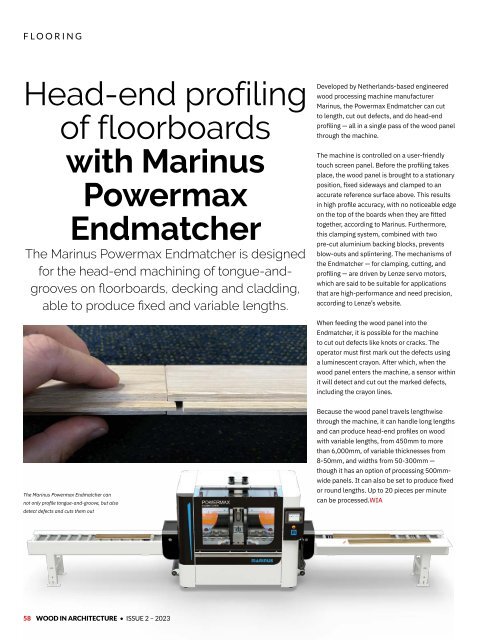WIA_ISSUE2_2023
Create successful ePaper yourself
Turn your PDF publications into a flip-book with our unique Google optimized e-Paper software.
FLOORING<br />
Head-end profiling<br />
of floorboards<br />
with Marinus<br />
Powermax<br />
Endmatcher<br />
The Marinus Powermax Endmatcher is designed<br />
for the head-end machining of tongue-andgrooves<br />
on floorboards, decking and cladding,<br />
able to produce fixed and variable lengths.<br />
Developed by Netherlands-based engineered<br />
wood processing machine manufacturer<br />
Marinus, the Powermax Endmatcher can cut<br />
to length, cut out defects, and do head-end<br />
profiling — all in a single pass of the wood panel<br />
through the machine.<br />
The machine is controlled on a user-friendly<br />
touch screen panel. Before the profiling takes<br />
place, the wood panel is brought to a stationary<br />
position, fixed sideways and clamped to an<br />
accurate reference surface above. This results<br />
in high profile accuracy, with no noticeable edge<br />
on the top of the boards when they are fitted<br />
together, according to Marinus. Furthermore,<br />
this clamping system, combined with two<br />
pre-cut aluminium backing blocks, prevents<br />
blow-outs and splintering. The mechanisms of<br />
the Endmatcher — for clamping, cutting, and<br />
profiling — are driven by Lenze servo motors,<br />
which are said to be suitable for applications<br />
that are high-performance and need precision,<br />
according to Lenze’s website.<br />
When feeding the wood panel into the<br />
Endmatcher, it is possible for the machine<br />
to cut out defects like knots or cracks. The<br />
operator must first mark out the defects using<br />
a luminescent crayon. After which, when the<br />
wood panel enters the machine, a sensor within<br />
it will detect and cut out the marked defects,<br />
including the crayon lines.<br />
The Marinus Powermax Endmatcher can<br />
not only profile tongue-and-groove, but also<br />
detect defects and cuts them out<br />
Because the wood panel travels lengthwise<br />
through the machine, it can handle long lengths<br />
and can produce head-end profiles on wood<br />
with variable lengths, from 450mm to more<br />
than 6,000mm, of variable thicknesses from<br />
8-50mm, and widths from 50-300mm —<br />
though it has an option of processing 500mmwide<br />
panels. It can also be set to produce fixed<br />
or round lengths. Up to 20 pieces per minute<br />
can be processed.<strong>WIA</strong><br />
58 WOOD IN ARCHITECTURE • ISSUE 2 – <strong>2023</strong>

















